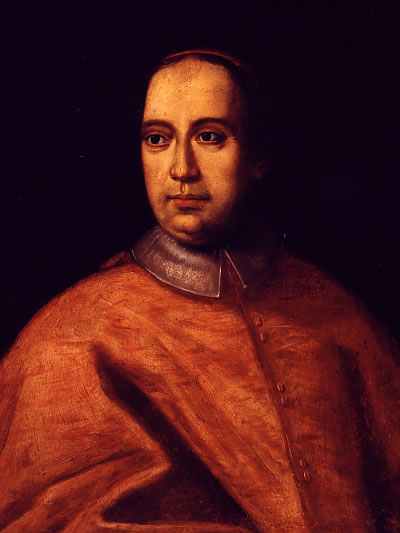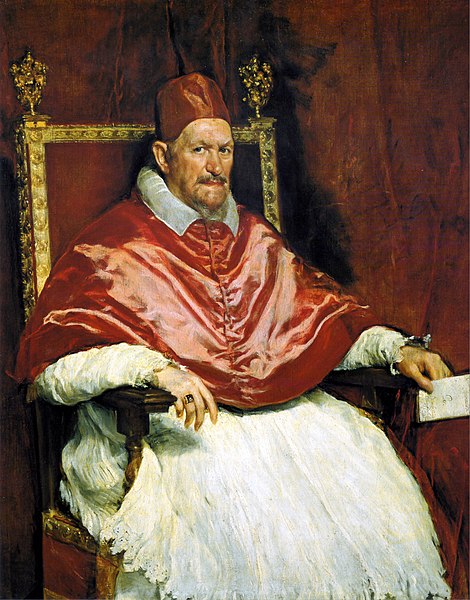This Week in Classical Music: April 24, 2023.Benedetto Pamphili.Occasionally we write about historical figures that, while not directly involved in composing or making music, greatly affected musical culture, for example, through their patronage, as librettists, or as music producers.Queen Christina is probably the most famous example of a patron.In a very different way, Pietro Metastasio, who wrote libretti to operas by Vinci, Caldara, Hasse, and many other opera seria composers, was also very influential.And then there was Lorenzo da Ponte: we know him as the librettist to Mozart’s Don Giovanni, Così fan tutte, and The Marriage of Figaro, but he also wrote libretti for 25 other operas by 11 composers, Antonio Salieri among them.The famous impresario Sol Hurok is an example of a powerful producer who shaped several musical careers.
Cardinal Benedetto Pamphili, whom we are celebrating today, was prominent in all three areas: he was an important benefactor, he wrote several libretti, and he staged many productions, some of which were premiers.Benedetto Pamphili was born in Rome on April 25th of 1653 into a prominent family whose name in Italian is often spelled Pamphilj, the ending “j” indicating a long “e” sound.Benedetto’s great-grandfather was Pope Innocent X, whose portrait you can see below.(The portrait, one of the greatest ever created, was painted by Diego Velázquez.It now hangs in a separate room in Galleria Doria Pamphilj; it alone is worth the price of the ticket.Read more about it here).Benedetto’s parents were Cardinal Camillo Pamphilj and Olimpia Aldobrandini, from a no less powerful Aldobrandini family.In order to marry Olimpia, Camillo had to renounce his cardinalship.The Palazzo Doria Pamphilj, which houses the gallery, was part of Olimpia’s dowry; prior to her marriage, it was called Palazzo Aldobrandini (the original Palazzo Pamphilj is on Piazza Navona and is now owned by the Brazilian embassy).
Benedetto, who inherited a fortune, also had a considerable income from numerous ecclesiastical positions he was granted by Pope Innocent XI.He spent much of it on art and patronage.Benedetto was a gifted writer and was admitted into two prestigious Academies: Accademia degli Umoristi, a literary society whose members were some of the best writers of the time (despite its name the Academy wasn’t necessarily dedicated to humoristic arts), and Accademia dell'Arcadia, about which we wrote an entry some time ago.As music was Benedetto’s favorite art, he applied his literary talents to writing libretti.Operas were prohibited in Rome by Pope Clement XI in 1703, so most of these libretti were for oratorios and cantatas, which temporarily replaced operas as accepted genres (texts for 88 cantatas are extant).A few of Benedetto’s operas were staged before the prohibition went into effect, for example, Alessandro Scarlatti’s La santa Dimna, presented in Palazzo Doria Pamphilj in 1687.
Benedetto employed several maestro di musica, among them Lulier and Cesarini.Arcangelo Corelli played in his orchestra and was handsomely rewarded for it.Bernardo Pasquini, a composer of operas and oratorios, was also supported by Benedetto, as was Giovanni Bononcini.His most famous charge was Handel during the young composer’s stay in Rome.They became friends and Handel dedicated several cantatas and oratorios to his patron.
Benedetto held weekly musical events in his palace, as did some other powererful cardinals, like Pietro Ottoboni and Carlo Colonna; he also sponsored productions in other theaters.What is interesting about these productions is the size of the orchestras they employed.We are used to the staging of Baroque operas supported by scaled-down groups, often consisting of just several players: a couple of violins, a viola da gamba, a theorbo, and a harpsichord.According to Lowell Lindgren, Benedetto employed 32 musicians in Scarlatti's Il trionfo della gratia and 60 for Lulier's S Maria Maddalena de' pazzi.Maybe the musical accompaniment of Baroque operas doesn’t have to sound so thin after all.
Benedetto Pamphili, 2023
This Week in Classical Music: April 24, 2023. Benedetto Pamphili. Occasionally we write about historical figures that, while not directly involved in composing or making music, greatly affected musical culture, for example, through their patronage, as librettists, or as music producers. Queen Christina is probably the most famous example of a patron. In a very different way, Pietro Metastasio, who wrote libretti to operas by Vinci, Caldara, Hasse, and many other opera seria composers, was also very influential. And then there was Lorenzo da Ponte: we know him as the librettist to Mozart’s Don Giovanni, Così fan tutte, and The Marriage of Figaro, but he also wrote libretti for 25 other operas by 11 composers, Antonio Salieri among them. The famous impresario Sol Hurok is an example of a powerful producer who shaped several musical careers.
affected musical culture, for example, through their patronage, as librettists, or as music producers. Queen Christina is probably the most famous example of a patron. In a very different way, Pietro Metastasio, who wrote libretti to operas by Vinci, Caldara, Hasse, and many other opera seria composers, was also very influential. And then there was Lorenzo da Ponte: we know him as the librettist to Mozart’s Don Giovanni, Così fan tutte, and The Marriage of Figaro, but he also wrote libretti for 25 other operas by 11 composers, Antonio Salieri among them. The famous impresario Sol Hurok is an example of a powerful producer who shaped several musical careers.
Cardinal Benedetto Pamphili, whom we are celebrating today, was prominent in all three areas: he was an important benefactor, he wrote several libretti, and he staged many productions, some of which were premiers. Benedetto Pamphili was born in Rome on April 25th of 1653 into a prominent family whose name in Italian is often spelled Pamphilj, the ending “j” indicating a long “e” sound. Benedetto’s great-grandfather was Pope Innocent X, whose portrait you can see below. (The portrait, one of the greatest ever created, was painted by Diego Velázquez. It now hangs in a separate room in Galleria Doria Pamphilj; it alone is worth the price of the ticket. Read more about it here). Benedetto’s parents were Cardinal Camillo Pamphilj and Olimpia Aldobrandini, from a no less powerful Aldobrandini family. In order to marry Olimpia, Camillo had to renounce his cardinalship. The Palazzo Doria Pamphilj, which houses the gallery, was part of Olimpia’s dowry; prior to her marriage, it was called Palazzo Aldobrandini (the original Palazzo Pamphilj is on Piazza Navona and is now owned by the Brazilian embassy).
portrait, one of the greatest ever created, was painted by Diego Velázquez. It now hangs in a separate room in Galleria Doria Pamphilj; it alone is worth the price of the ticket. Read more about it here). Benedetto’s parents were Cardinal Camillo Pamphilj and Olimpia Aldobrandini, from a no less powerful Aldobrandini family. In order to marry Olimpia, Camillo had to renounce his cardinalship. The Palazzo Doria Pamphilj, which houses the gallery, was part of Olimpia’s dowry; prior to her marriage, it was called Palazzo Aldobrandini (the original Palazzo Pamphilj is on Piazza Navona and is now owned by the Brazilian embassy).
Benedetto, who inherited a fortune, also had a considerable income from numerous ecclesiastical positions he was granted by Pope Innocent XI. He spent much of it on art and patronage. Benedetto was a gifted writer and was admitted into two prestigious Academies: Accademia degli Umoristi, a literary society whose members were some of the best writers of the time (despite its name the Academy wasn’t necessarily dedicated to humoristic arts), and Accademia dell'Arcadia, about which we wrote an entry some time ago. As music was Benedetto’s favorite art, he applied his literary talents to writing libretti. Operas were prohibited in Rome by Pope Clement XI in 1703, so most of these libretti were for oratorios and cantatas, which temporarily replaced operas as accepted genres (texts for 88 cantatas are extant). A few of Benedetto’s operas were staged before the prohibition went into effect, for example, Alessandro Scarlatti’s La santa Dimna, presented in Palazzo Doria Pamphilj in 1687.
Benedetto employed several maestro di musica, among them Lulier and Cesarini. Arcangelo Corelli played in his orchestra and was handsomely rewarded for it. Bernardo Pasquini, a composer of operas and oratorios, was also supported by Benedetto, as was Giovanni Bononcini. His most famous charge was Handel during the young composer’s stay in Rome. They became friends and Handel dedicated several cantatas and oratorios to his patron.
Benedetto held weekly musical events in his palace, as did some other powererful cardinals, like Pietro Ottoboni and Carlo Colonna; he also sponsored productions in other theaters. What is interesting about these productions is the size of the orchestras they employed. We are used to the staging of Baroque operas supported by scaled-down groups, often consisting of just several players: a couple of violins, a viola da gamba, a theorbo, and a harpsichord. According to Lowell Lindgren, Benedetto employed 32 musicians in Scarlatti's Il trionfo della gratia and 60 for Lulier's S Maria Maddalena de' pazzi. Maybe the musical accompaniment of Baroque operas doesn’t have to sound so thin after all.